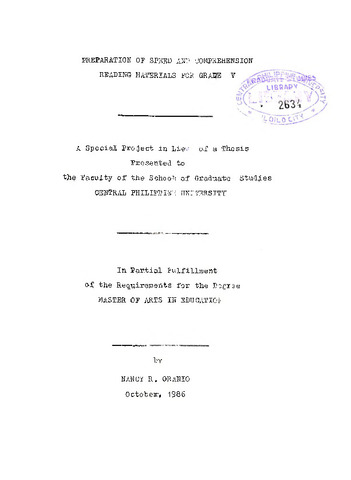Показать сокращенную информацию
Preparation of speed and comprehension reading materials for grade V
| dc.contributor.adviser | Griño, Eliza U. | |
| dc.contributor.author | Oranio, Nancy R. | |
| dc.date.accessioned | 2021-09-20T02:34:11Z | |
| dc.date.available | 2021-09-20T02:34:11Z | |
| dc.date.issued | 1986 | |
| dc.identifier.citation | Oranio, N. R. (1986). Preparation of speed and comprehension reading materials for grade V (Unpublished Master’s special paper). Central Philippine University, Jaro, Iloilo City. | en_US |
| dc.identifier.uri | https://hdl.handle.net/20.500.12852/1392 | |
| dc.description | Introduction and statement of the problem | en_US |
| dc.description.abstract | Background of the Study Reading is a tool subject essential in the study of other subjects like Social Studies, Science, and Mathematics, Successful reading is a two-way process. The wealth of information and the degree of pleasure a reader gets from the printed page depend on how much of himself, in the form of experience, he gives to the reading act, for reading is a give-and-take affair between the author and the reader himself . In learning to read, however, children do not all progress at the same speed. They vary in their levels of perception and in their ability to react to what has been read. It is sad to note that many elementary school pupils, high school students, and even college students are poor readers, slow in speed and/or comprehension. To deal with this problem, the Ministry of Education, Culture and Sports (MECS) has ordered the field to use particular teaching approaches, procedures, techniques, and materials. It has taken pains to update teachers’ competencies through in-service training, teach-ins, seminars, and workshops. These studies such as Programmed Reading by Cynthia Dee Buchanan and Sullivan Associates (1964)1, the Learning Experience Approach by Joe L. Frost (1967)2 and the SRA Approach or the Individualized Approach, were all tried out at Philippine Normal College. The first used the small-step approach of programmed reading. The second used the experience of the child to enhance effective learning. The third approach used the SRA materials which are used by the children individually as they learn the basic reading skills. All were found to be significantly useful in improving vocabulary, speed and comprehension, John Fontillas of De La Salle College, Manila conducted a study similar to that of SRA Approach and came up with the same results. These approaches in the enhancement of comprehension of school children and students are now used nationwide. Despite the efforts expended by the Ministry, developing speed and comprehension among the pupils is still one of the crucial problems in the educational system of the country. Because they are aware of this weakness in the system, the 1984-85 MECSRO VI-CPU reading grantees accepted, the responsibility of preparing speed-and-comprehension materials. It is hoped that the materials produced will help teachers in the field to properly measure the speed and comprehension levels of the intermediate pupils as well as guide the teachers as they offer instruction in reading. It is hoped that the pupils using the materials will improve their skills in reading and derive comprehension in other content areas such as Science, Mathematics and Social Studies, Statement of the Problem This study is an attempt to prepare reading materials that can measure the speed and the comprehension of Grade V pupils in Region VI. It was also sought to find out whether these materials are within the reading level of Grade V pupils especially those of Kabankalan III, Division of Negros Occidental, since these materials are based on their responses to the study. Specifically, it aims to answer these questions: 1. Do the reading materials reflect the interest of the Grade V children? 2. Are the prepared reading materials suited to the reading level of Grade V pupils? Are they appropriate? 4. Are the test exercises valid? Are they reliable? Are all the distractors functional? | en_US |
| dc.format.extent | 127 leaves | en_US |
| dc.language.iso | en | en_US |
| dc.subject.ddc | GSL Theses 378.242 Or1 | en_US |
| dc.subject.lcsh | Reading comprehension | en_US |
| dc.subject.lcsh | Reading comprehension--Ability testing | en_US |
| dc.subject.lcsh | Speed reading | en_US |
| dc.subject.lcsh | Speed reading--Ability testing | en_US |
| dc.subject.lcsh | Reading (Elementary) | en_US |
| dc.subject.lcsh | Reading--Aids and devices | en_US |
| dc.subject.lcsh | Reading (Elementary)--Ability testing | en_US |
| dc.subject.lcsh | Reading interests | en_US |
| dc.title | Preparation of speed and comprehension reading materials for grade V | en_US |
| dc.title.alternative | Preparation of speed and comprehension reading materials for grade 5 | en_US |
| dc.type | Special paper | en_US |
| dc.description.bibliographicalreferences | Includes bibliographical references | en_US |
| dc.contributor.chair | Herradura, Elma S. | |
| dc.contributor.committeemember | Cang, Febe A. | |
| dc.contributor.committeemember | Porter, Josefina Y. | |
| dc.contributor.committeemember | Grecia, Elsa L. | |
| dc.contributor.committeemember | Ruiz, Macario B. | |
| dc.contributor.committeemember | Traviña, Miriam M. | |
| dc.contributor.committeemember | Pahunao, Elnora | |
| dc.contributor.department | School of Graduate Studies | en_US |
| dc.description.degree | Master of Arts in Education with specialization in Reading (English) | en_US |


